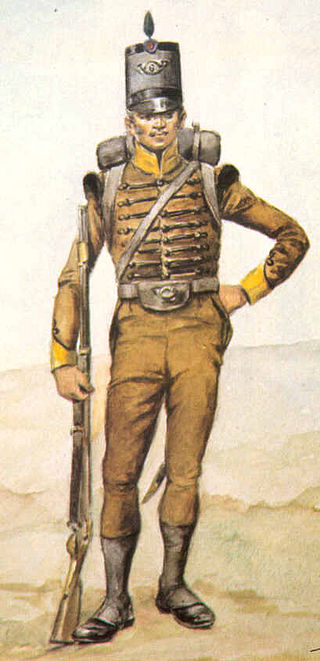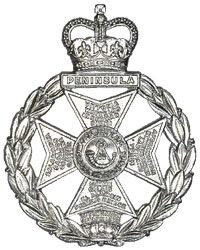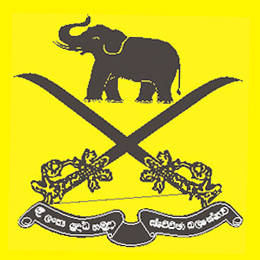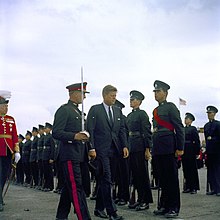
The King's Royal Rifle Corps was an infantry rifle regiment of the British Army that was originally raised in British North America as the Royal American Regiment during the phase of the Seven Years' War in North America known in the United States as 'The French and Indian War.' Subsequently numbered the 60th Regiment of Foot, the regiment served for more than 200 years throughout the British Empire. In 1958, the regiment joined the Oxfordshire and Buckinghamshire Light Infantry and the Rifle Brigade in the Green Jackets Brigade and in 1966 the three regiments were formally amalgamated to become the Royal Green Jackets. The KRRC became the 2nd Battalion, Royal Green Jackets. On the disbandment of the 1st Battalion, Royal Green Jackets in 1992, the RGJ's KRRC battalion was redesignated as the 1st Battalion, Royal Green Jackets, eventually becoming 2nd Battalion, The Rifles in 2007.

Light infantry refers to certain types of lightly-equipped infantry throughout history. They have a more mobile or fluid function than other types of infantry, such as heavy infantry or line infantry. Historically, light infantry often fought as scouts, raiders, and skirmishers. These are loose formations that fight ahead of the main army to harass, delay, disrupt supply lines, engage the enemy's own skirmishing forces, and generally "soften up" an enemy before the main battle. Light infantrymen were also often responsible for screening the main body of a military formation.

The 2nd King Edward VII's Own Gurkha Rifles (The Sirmoor Rifles) was a rifle regiment of the British Indian Army before being transferred to the British Army on India's independence in 1947. The 4th Battalion joined the Indian Army as the 5th Battalion, 8th Gorkha Rifles (Sirmoor Rifles), where it exists to this day. As part of the British Army, the regiment served in Malaya, Hong Kong and Brunei until 1994 when it was amalgamated with the other three British Army Gurkha infantry regiments to form the Royal Gurkha Rifles. It is the only Gurkha regiment which did not have a khukuri on its cap badge.
The Baker rifle was a flintlock rifle used by the rifle regiments of the British Army during the Napoleonic Wars. It was the first British-made rifle that the British armed forces issued as a standard weapon for all line companies in a regiment. The Pattern 1776 Infantry rifle had been issued on a limited basis of 10 per regiment to units serving in the American War of Independence.
The hackle is a clipped plume or short spray of coloured feathers that is attached to a military headdress, with different colours being associated with particular regiments.

In military organizations, the practice of carrying colours, standards, flags, or guidons, both to act as a rallying point for troops and to mark the location of the commander, is thought to have originated in Ancient Egypt some 5,000 years ago. The Roman Empire also made battle standards reading SPQR a part of their vast armies. It was formalized in the armies of Europe in the High Middle Ages, with standards being emblazoned with the commander's coat of arms.

The Royal Green Jackets (RGJ) was an infantry regiment of the British Army, one of two "large regiments" within the Light Division.

The Rifle Brigade (The Prince Consort's Own) was an infantry rifle regiment of the British Army formed in January 1800 as the "Experimental Corps of Riflemen" to provide sharpshooters, scouts, and skirmishers. They were soon renamed the "Rifle Corps". In January 1803, they became an established regular regiment and were titled the 95th Regiment of Foot (Rifles). In 1816, at the end of the Napoleonic Wars, they were again renamed, this time as the "Rifle Brigade".
The Rifles is an infantry regiment of the British Army. Formed in 2007, it consists of four Regular battalions and three Reserve battalions. Each Regular battalion of The Rifles was formerly an individual battalion of one of the two large regiments of the Light Division. Since formation, the regiment has been involved in combat operations in the later stages of the Iraq War and in the War in Afghanistan.

A battle honour is an award of a right by a government or sovereign to a military unit to emblazon the name of a battle or operation on its flags ("colours"), uniforms or other accessories where ornamentation is possible.

Line infantry was the type of infantry that formed the bulk of most European land armies from the mid-17th century to the mid-19th century. Maurice of Nassau and Gustavus Adolphus are generally regarded as its pioneers, while Turenne and Montecuccoli are closely associated with the post-1648 development of linear infantry tactics. For both battle and parade drill, it consisted of two to four ranks of foot soldiers drawn up side by side in rigid alignment, and thereby maximizing the effect of their firepower. By extension, the term came to be applied to the regular regiments "of the line" as opposed to light infantry, skirmishers, militia, support personnel, plus some other special categories of infantry not focused on heavy front line combat.
The Light Division is a light infantry division of the British Army. It was reformed in 2022, as part of Future Soldier reforms.

A rifleman is an infantry soldier armed with a rifled long gun. Although the rifleman role had its origin with 16th century hand cannoneers and 17th century musketeers, the term originated in the 18th century with the introduction of the rifled musket. By the mid-19th century, entire regiments of riflemen were formed and became the mainstay of all standard infantry, and rifleman became a generic term for any common infantryman.
The British Army is listed according to an order of precedence for the purposes of parading. This is the order in which the various corps of the army parade, from right to left, with the unit at the extreme right being highest. Under ordinary circumstances, the Household Cavalry parades at the extreme right of the line. Militia and Army Reserve units take precedence after Regular units with the exception of The Honourable Artillery Company and The Royal Monmouthshire Royal Engineers.

At the time of Indian Independence in 1947, as per the terms of the Britain–India–Nepal Tripartite Agreement, six Gorkha regiments, formerly part of the British Indian Army, became part of the Indian Army and have served ever since. The troops are mainly from ethnic Gurkha communities of India and Nepal. A seventh Gorkha Rifles regiment was re-raised in the Indian Army after Independence to accommodate Gorkha soldiers of the 7th Gurkha Rifles and the 10th Gurkha Rifles who chose not to transfer to the British Army.
The 9th Battalion, London Regiment was a Territorial Army infantry battalion of the British Army. The London Regiment was formed in 1908 in order to regiment the various Volunteer Force battalions in the newly formed County of London, and the Queen Victoria's Rifles were one of twenty six units brought together in this way.

The Sri Lanka Army Volunteer Force (SLAVF) is the active-duty volunteer reserve force of the Sri Lanka Army. The SLAVF is separate from the Regular Force which consists of personal who are professional soldiers and its Regular Reserve, which comprises personal who have a mobilization obligation following their service in the regular army. The SLAVF consists of the volunteer force and the volunteer reserve; administration and recruitment of reserve personal is carried out by the Volunteer Force Headquarters in Shalawa, Kosgama which is headed by the Commandant of the Volunteer Force. It has a current strength of about 55,000 personnel. The SLAVF was known as the Ceylon Volunteer Force from 1949 to 1972 and the Sri Lanka Volunteer Force from 1972 to 1985.
The history of British light infantry goes back to the early days of the British Army, when irregular troops and mercenaries added skills in light infantry fighting. From the beginning of the nineteenth century, the Army dedicated some line regiments as specific light infantry troops, were trained under the Shorncliffe System devised by Sir John Moore and Sir Kenneth MacKenzie Douglas. The light infantry had the nickname "light bobs" first used during the American Wars of Independence, and commonly applied to the Light Division during the Napoleonic wars.

A sharpshooter is one who is highly proficient at firing firearms or other projectile weapons accurately. Military units composed of sharpshooters were important factors in 19th-century combat. Along with "marksman" and "expert", "sharpshooter" is one of the three marksmanship badges awarded by the United States Army and the United States Marine Corps. The United States Navy and the United States Coast Guard use a ribbon with an attached "S" device to note a sharpshooter qualification.
The Band and Bugles of the Rifles is a military band serving as the regimental band for The Rifles, the sole rifle regiment and the largest in the British Army. It is the senior most of three bands in the regiment and is the only one that is part of the regular army. Uniquely, it employs bugles at its front, a tradition that goes back to the conflicts of the 18th century. Major Séan O’Neill is currently serving as the Director of Music (DOM) of the band and bugles. It is part of the Royal Corps of Army Music.













